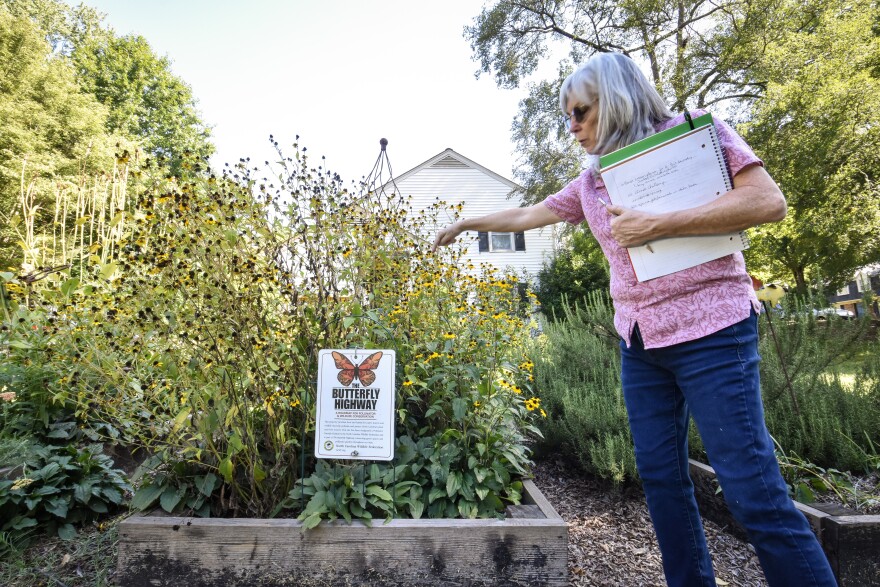Many of us like to invite friends to our homes for dinner or drinks, but Stonehaven neighborhood resident Donna Bolls wants us to invite other types of visitors to our homes — like those with feathers or tiny legs and wings.
On a recent walk through her yard, Bolls pointed out a goldfinch swooping up to a branch, a tiny bee buzzing through her black-eyed Susans and a vulture circling overhead.
Her yard is a Certified Wildlife Habitat, meaning it has bird feeders, wildflowers and piles of leaves spread out under her trees.
"Birds will forage in there," Bolls said, pointing out the leaves. "Other animals will forage in there. You'll start to see fireflies again, because they need that."
Bolls is trying to get enough of her neighbors to join her to make Stonehaven Charlotte's first Community Wildlife Habitat, as certified by the National Wildlife Federation.
WFAE's Nick de la Canal spoke with Bolls, who is also president of the Charlotte Wildlife Stewards, the local branch of the North Carolina Wildlife Federation.
Nick de la Canal: Have you always had a yard buzzing with bees and birds and ants?
Donna Bolls: Well, I think they've always been here, but I didn't really get seriously into gardening until 10 or 12 years ago, and that's when I was gardening for what looks great. And then about five years ago, I found out about the native plant studies certification course through the Native Plant Society in UNCC, started taking those classes, and was like, oh wow. I've done a lot of things that I could have done differently. So now, going forward, everything I'm planting is a native species.

De la Canal: Why did you then start approaching your neighbors here in Stonehaven and encouraging them to make their yards more friendly to wildlife?
Bolls: Well, we have lost so much natural habitat to development. And Stonehaven is an old neighborhood. You can see — I mean one of the advantages we have here is a lot of the old growth trees. We have a large population of bard owls, we have hawks, we have lots of other wildlife, and part of it is educating them that it's okay for possums and raccoons and snakes and lizards, bats, bunnies — you know, we share our world with them, and so what we want to do is support them.
De la Canal: If a neighbor says that they're open to having their yard become more friendly to wildlife or wildlife habitat, what do you start working with them on?
Bolls: Well there are four things that all living things need. We need food, water, shelter for weather — shelter from predators and we need places to raise our young. The other thing that's encouraged is using sustainable gardening practices or yard practices, like not using fertilizers, not using pesticides, plant native species, avoid the mosquito spraying. It's kind of a change in mindset of welcoming those little tiny things in. You know, each one of our yards is sort of like a silo, and if each one can support wildlife, then we're creating a corridor for that wildlife.

De la Canal: So how close is your neighborhood to getting this community wildlife habitat certification?
Bolls: Well we're in the beginning stages, but we've made actually really good headway. We have certain activities that we get points for. It's a total of 150 points, and we have 141, but we're still lacking points in the outreach.
De la Canal: Well I'll be rooting for that — for you guys to get that. I also wanted to ask, what's something you think is perhaps the most impactful thing that people can do to make their yards more friendly to wildlife?
Bolls: Oh, I would say increasing your natural areas, reducing your lawn. A statistic from 2005 said that there was 40 million acres of lawn in the United States, and if we could half that, that would make a huge impact.
De la Canal: Well it looks like I'll have to spend some more time on my yard this season. Thank you, Donna.
Bolls: You're welcome.
De la Canal: She is a Stonehaven resident and also president of the Charlotte Wildlife Stewards. That's the local chapter of the North Carolina Wildlife Federation.


